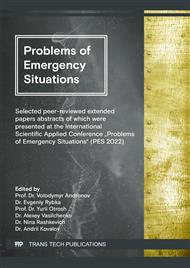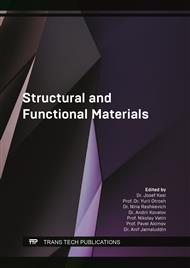[1]
A. Lovska, O. Fomin, A new fastener to ensure the reliability of a passenger car body on a train ferry, Acta Polytech., 60(6) (2020) 478-485.
DOI: 10.14311/ap.2020.60.0478
Google Scholar
[2]
A. Kondratiev, V. Píštěk, L. Smovziuk, M. Shevtsova, A. Fomina, P. Kučera, A. Prokop, Effects of the Temperature–Time Regime of Curing of Composite Patch on Repair Process Efficiency, Polym., 13(24) (2021) 4342.
DOI: 10.3390/polym13244342
Google Scholar
[3]
T. Temesi, T. Czigany, Integrated Structures from Dissimilar Materials: The Future Belongs to Aluminum–Polymer Joints, Adv. Eng. Mater., 22(8) (2020) 2000007.
DOI: 10.1002/adem.202000007
Google Scholar
[4]
S. Ugrimov, N. Smetankina, O. Kravchenko, V. Yareshchenko, Analysis of Laminated Composites Subjected to Impact, Springer International Publishing, in Integrated Computer Technologies in Mechanical Engineering - 2020, Cham, 2021, 188 (2021) 234-246.
DOI: 10.1007/978-3-030-66717-7_19
Google Scholar
[5]
S.Y. Yoo, C.H. Kim, J.H. Kweon, J.H. Choi, The structural analysis and strength evaluation of the rivet nut joint for composite repair, Compos. Struct., 136 (2016) 662-668.
DOI: 10.1016/j.compstruct.2015.11.012
Google Scholar
[6]
V. Kombarov, Y. Kryzhyvets, I. Biletskyi, Y. Tsegelnyk, Y. Aksonov, L. Piddubna, Numerical Control of Fiberglass Pipe Bends Manufacturing, 2021 IEEE 2nd KhPI Week on Advanced Technology (KhPIWeek), (2021) 357-362.
DOI: 10.1109/khpiweek53812.2021.9570068
Google Scholar
[7]
Y. Otrosh, Y. Rybka, O. Danilin, M. Zhuravskyi, Assessment of the technical state and the possibility of its control for the further safe operation of building structures of mining facilities, E3S Web of Conferences, 123 (2019) 01012.
DOI: 10.1051/e3sconf/201912301012
Google Scholar
[8]
F. Sen, K. Aldas, Effects of Using Different Metal Materials on Stresses in Metal-Composite Hybrid Joints, Çankaya Univ. J. Human. Soc. Sci., 8 (2011) 1-14.
Google Scholar
[9]
Y. Otrosh, A. Kovalov, O. Semkiv, I. Rudeshko, V. Diven, Methodology remaining lifetime determination of the building structures, MATEC Web Conf., 230 (2018) 02023.
DOI: 10.1051/matecconf/201823002023
Google Scholar
[10]
J. Xiang, S. Zhao, D. Li, Y. Wu, An improved spring method for calculating the load distribution in multi-bolt composite joints, Compos. Part B: Eng., 117 (2017) 1-8.
DOI: 10.1016/j.compositesb.2017.02.024
Google Scholar
[11]
V.S. Romanov, M. Heidari-Rarani, L. Lessard, A parametric study on static behavior and load sharing of multi-bolt hybrid bonded/bolted composite joints, Compos. Part B: Eng., 217 (2021) 108897.
DOI: 10.1016/j.compositesb.2021.108897
Google Scholar
[12]
O.Z. Dveirin, O.V. Andreev, A.V. Kondrat'ev, V.Y. Haidachuk, Stressed State in the Vicinity of a Hole in Mechanical Joint of Composite Parts, Int. Appl. Mechan., 57(2) (2021) 234-247.
DOI: 10.1007/s10778-021-01076-4
Google Scholar
[13]
A. Kondratiev, V. Píštěk, L. Smovziuk, M. Shevtsova, A. Fomina, P. Kučera, Stress–strain behaviour of reparable composite panel with step–variable thickness, Polym., 13(21) (2021) 3830.
DOI: 10.3390/polym13213830
Google Scholar
[14]
S. Chandregowda, G.R.C. Reddy, Evaluation of fastener stiffness modelling methods for aircraft structural joints, AIP Conf. Proceed., 1943(1) (2018) 020001.
DOI: 10.1063/1.5029577
Google Scholar
[15]
G. Beketova, M. Shevtsova, V. Symonov, Static and Fatigue Characteristics of Pinned Metal-Composite Joints, Mechan. Compos. Mater., 55(5) (2019) 655-666.
DOI: 10.1007/s11029-019-09842-9
Google Scholar
[16]
V. Eremin, A. Bolshikh, V. Koroliskii, K. Shelkov, Methods for flexibility determination of bolted joints: empirical formula review, J. Physics: Conf. Series, 1925(1) (2021) 012058.
DOI: 10.1088/1742-6596/1925/1/012058
Google Scholar
[17]
A.V. Kondratiev, V.E. Gaidachuk, Mathematical Analysis of Technological Parameters for Producing Superfine Prepregs by Flattening Carbon Fibers, Mechan. Compos. Mater., 57(1) (2021) 91-100.
DOI: 10.1007/s11029-021-09936-3
Google Scholar
[18]
K. Ramaswamy, R.M. O'Higgins, M.C. Corbett, M.A. McCarthy, C.T. McCarthy, Quasi-static and dynamic performance of novel interlocked hybrid metal-composite joints, Compos. Struct., 253 (2020) 112769.
DOI: 10.1016/j.compstruct.2020.112769
Google Scholar
[19]
R. Martins, S.P. Ernani, L.A, Influence of Types of Discrete Modelling of Fasteners in FEM Models, Proc. Int. Conf. on NAFEMS World Congress, (2017).
Google Scholar
[20]
P.P. Yuan, W.X. Ren, J. Zhang, Dynamic tests and model updating of nonlinear beam structures with bolted joints, Mech. Syst. Signal Proc., 126 (2019) 193-210.
DOI: 10.1016/j.ymssp.2019.02.033
Google Scholar
[21]
V.P. Eremin, A. Bolshikh, Global-local modeling of single-shear composite – metal and composite – composite bolt joints in aircraft structural components, Eng. J.: Sci. Innovat., 5(101) (2020).
DOI: 10.18698/2308-6033-2020-5-1981
Google Scholar
[22]
C. Gerendt, A. Dean, T. Mahrholz, N. Englisch, S. Krause, R. Rolfes, On the progressive fatigue failure of mechanical composite joints: Numerical simulation and experimental validation, Compos. Struct., 248 (2020) 112488.
DOI: 10.1016/j.compstruct.2020.112488
Google Scholar
[23]
A. Kondratiev, V. Píštěk, S. Purhina, M. Shevtsova, A. Fomina, P. Kučera, Self-Heating Mould for Composite Manufacturing, Polym., 13(18) (2021) 3074.
DOI: 10.3390/polym13183074
Google Scholar
[24]
R. Medeiros, M. Ribeiro, V. Tita, Experimental methodology for testing metal-composite bolted joints, J. Miner., Met. Mater. Eng., 2 (2016) 11-22.
DOI: 10.20941/2414-2115.2016.02.3
Google Scholar
[25]
V. Golovanevskiy, A. Kondratiev, Elastic Properties of Steel-Cord Rubber Conveyor Belt, Exper. Techn., 45(2) (2021) 217-226.
DOI: 10.1007/s40799-021-00439-3
Google Scholar
[26]
L. Adamos, T. Loutas, Challenges in the fatigue crack growth characterization of metal/composite joints: A compliance-based investigation of a Ti/CFRP joint, Int. J. Fatigue, (148) (2021) 106233.
DOI: 10.1016/j.ijfatigue.2021.106233
Google Scholar
[27]
I.I. Sorokina, M.V. Astahov, E.V. Slavkina, Statistical Analysis of Test Results of Metal-Composite Compounds Under Action of Shear, in Proceedings of the 6th International Conference on Industrial Engineering (ICIE 2020). Lecture Notes in Mechanical Engineering, Springer, Cham, (2021) 456-463.
DOI: 10.1007/978-3-030-54814-8_54
Google Scholar
[28]
M.V. Astahov, I.I. Sorokina, E.V. Slavkina, To the Question of an Experimental Assessment of the Fatigue Characteristics of a Transversal Metal-Composite Compound, Solid State Phenom., 299 (2020) 241-245.
DOI: 10.4028/www.scientific.net/ssp.299.241
Google Scholar
[29]
S. Akbarpour, Hallström, Strength improvement of bolted joints in composite materials by use of patched metal inserts, Compos. Struct., 252 (2020) 112628.
DOI: 10.1016/j.compstruct.2020.112628
Google Scholar
[30]
D. Yoon, S. Kim, J. Kim, Y. Doh, Study on bearing strength and failure mode of a carbon-epoxy composite laminate for designing bolted joint structures, Compos. Struct., 239 (2020) 112023.
DOI: 10.1016/j.compstruct.2020.112023
Google Scholar
[31]
O. Dveirin, A. Tsaritsynskyy, T. Nabokina, A. Kondratiev, Assessment of Error of the Experimental Determination of Interlaminar Shear Strength,. In: Nechyporuk M., Pavlikov V., Kritskiy D. (eds) ICTM 2021. Lecture Notes in Networks and Systems. Springer, Cham, 367 (2021).
DOI: 10.1007/978-3-030-94259-5_2
Google Scholar
[32]
V. Shah, Handbook of plastics testing and failure analysis, fourth ed., Hoboken, NJ: John Wiley and Sons, Inc., (2020).
Google Scholar



